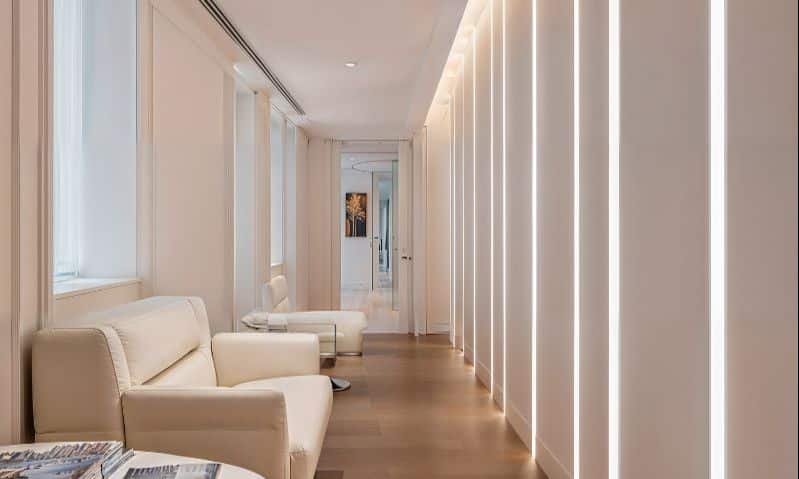n recent years, the professional lighting market has undergone a transformation thanks to COB technology, which made it possible to integrate multiple LED chips on the same board, achieving continuous and homogeneous light. However, innovation does not stop, and now an even more advanced evolution has arrived: WCOB LED technology.
This new generation of LEDs not only improves energy efficiency, but also offers a more uniform light, with no visible spots, an impeccable aesthetic finish and a longer service life. In this article, you’ll find out what makes WCOB so special, how it differs from traditional COB and why LED strips are becoming a favorite choice for architects, designers and users looking for the best in modern lighting.
Table of Contents
- What is WCOB LED technology
- WCOB LED operating principle
- WCOB vs. traditional COB: direct comparison
- Benefits of WCOB technology in modern LED lighting
- Differences with hybrid SMD and COB technologies
- Light output and color quality (CRI and CCT)
- Most common applications of the WCOB in today’s lighting
- WCOB and sustainability: greener light
- How to choose luminaires with WCOB technology for your space
What is WCOB LED technology
The acronym WCOB stands for White Chip-on-Board, which literally means “white chip mounted on board”. Its name accurately describes its principle of operation: instead of using blue LED chips with a yellow phosphor coating, as in conventional COB, WCOB uses individual white LED chips, each with its own phosphor coating.
This is very relevant because each chip in the WCOB system emits white light on its own, without relying on a common phosphor coating. This means that color conversion occurs individually on each LED, which reduces light losses, improves efficiency and avoids the typical yellow tones seen when the LED is off.
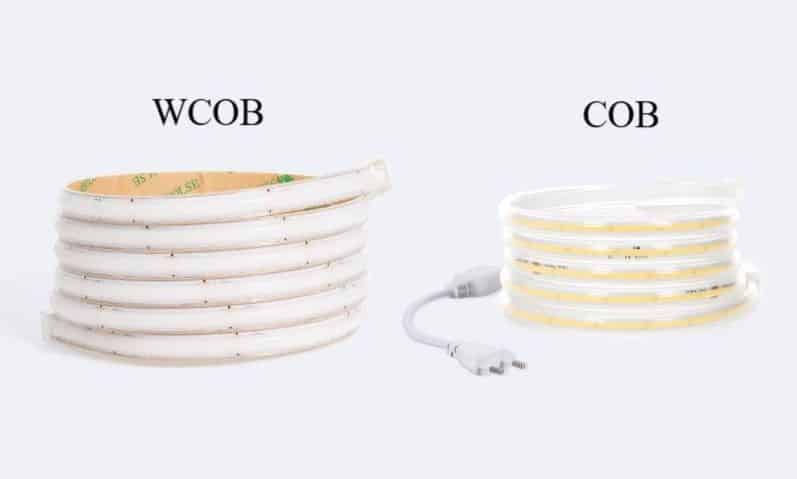
In a WCOB strip or module, these white chips are mounted at high density (many small LEDs are placed close together) on a flexible or rigid plate and coated with a thin layer of opal white silicon, which diffuses the light and generates a dotless effect. This results in a totally continuous and elegant illumination, perfect for high-end architectural, decorative or commercial applications.
WCOB LED operating principle
Each white LED chip (SMD or CSP type), inside a COB module, consists of a tiny semiconductor diode that emits blue light, covered by a phosphor layer that transforms part of that light into green and red wavelengths. The end result is an all-white light.
In the case of the WCOB, each of these chips already includes its own encapsulated phosphor, so that each dot emits pure white without relying on the rest. When hundreds of these microchips are mounted side by side on a plate and covered with a thin layer of translucent silicon, a perfectly uniform illumination is generated, without interruptions or shadows.
In addition, this architecture has another advantage: it reduces the optical losses that occur in traditional COB, where the common phosphor layer reflects part of the light back. By eliminating this barrier, the WCOB makes better use of each lumen generated, achieving efficiencies 30% to 50% higher compared to traditional COB versions.
From a technical point of view, the WCOB combines the best of two worlds:
- The continuous homogeneity of COB.
- The efficiency and flexibility of high-quality SMD LEDs.
This is why today it is considered the natural evolution of COB, especially for LED strips, linear luminaires and decorative systems where aesthetics and light quality are essential.
WCOB vs. traditional COB: direct comparison
To understand the real advantages of this new technology, it is worth seeing a clear comparison between the two systems:
| Feature | Traditional COB | WCOB (White COB) |
|---|---|---|
| Chip type | Blue LED + common phosphor layer | Single white LED (phosphor per chip) |
| Homogeneity | High (per continuous phosphor layer) | Very high (dense chips + opaline silicon) |
| Luminous efficiency | Good, but with retroreflective losses | Superior (up to +50 % in lm/W) |
| Thermal dissipation | Good, but concentrated | Better distributed, less thermal stress |
| Dull aesthetics | Yellow (visible phosphor) | Neutral and unobtrusive white |
| Cost of manufacture | Lower | Slightly higher (preconverted chips) |
| Durability | High | Very high (better thermal and mechanical control) |
As can be seen, the WCOB improves in virtually all relevant aspects with a cleaner design, higher performance and a much more attractive appearance even when the luminaire is off.
Benefits of WCOB technology in modern LED lighting
The success of WCOB is no accident. Its growing adoption is due to a list of advantages that impact both manufacturers and designers as well as end users:
- Superior energy efficiency: Thanks to their transparent structure and lower light loss, WCOB modules achieve up to 130 lm/W or more, reducing power consumption for the same amount of light.
- Uniform and spotless light: Ideal for aluminum profiles, showcases or continuous ceilings. Its dotless effect eliminates light spots, generating a continuous light line.
- Better thermal management: SMD or CSP chips distribute heat better and prevent overheating. This prolongs lifetime and maintains efficiency over time.
- High color fidelity: State-of-the-art phosphors reproduce colors with high accuracy, making objects look more natural and pleasing.
- Aesthetic appeal: The opal white coating makes dull strips or modules look elegant, without the yellowish hue typical of COB.
- Durability and reliability: Thanks to their advanced materials, WCOB modules maintain their performance for thousands of hours, even under demanding conditions.
In short, the WCOB not only saves energy, but also beautifies and modernizes the spaces where it is installed.
Differences with hybrid SMD and COB technologies
To better understand the position of the WCOB within the LED universe, it is useful to also compare it with other very common LED types: SMD and hybrid COB.
SMD (Surface Mounted Device) LEDs are the most traditional in flexible strips. Each LED is a visible dot mounted on the surface of the circuit, separated by a few millimeters. Although they are inexpensive and easy to produce, they generate a dotted illumination that requires diffusers or opaline covers to disguise the dots. In addition, their efficiency depends on the type of encapsulation and the size of the chip.
The traditional COB, on the other hand, has already made a great leap forward by offering a continuous emission surface. However, since it is based on blue chips covered with a common phosphor layer, it has optical losses and a yellowish color when it is turned off.
The WCOB, on the other hand, combines the best of both: the continuity of COB and the modularity of SMD. By using preconverted white LEDs mounted close together, it offers a light with no visible spots, but also greater flexibility in design and manufacturing.
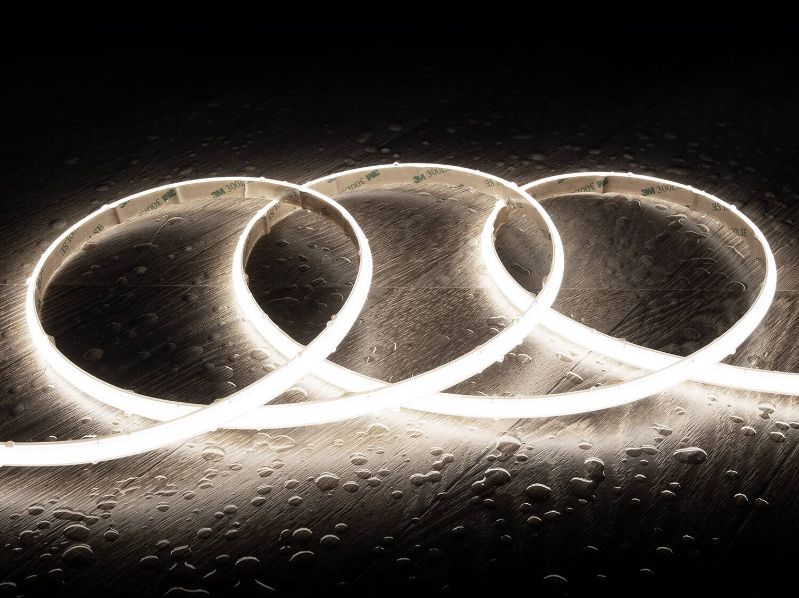
In addition, WCOB systems can adopt different formats (strips, rigid modules, circular or linear plates), whereas traditional COBs usually come in fixed modules. This opens up a range of creative possibilities for architects and interior designers looking for integrated, aesthetic and easy-to-install lighting solutions.
Light output and color quality (CRI and CCT)
One of the major attractions of the WCOB is its excellent light quality. Unlike other technologies, it can achieve color rendering indexes (CRI) above 90, even at high efficiency.
CRI measures the ability of a light source to show the true colors of objects. A high CRI is essential in retail stores, museums, studios or any space where color is part of the visual experience. WCOB modules maintain exceptional color fidelity thanks to their individual phosphor control and the use of chips selected (“binned”) within very narrow color ranges.
Another highlight is color stability. While in a traditional COB all chips depend on a common phosphor layer (which can degrade or vary with temperature), in WCOB each chip maintains a constant hue. This results in more uniform illumination and less color variation over time.
In terms of color temperature (CCT), WCOB modules are available in a wide range – from 2200 K warm to 6500 K cool white – and some models even offer tunable white versions, which allow the white hue to be modified according to the time of day or the desired ambience.
In short, the WCOB offers natural, stable and faithful light, ideal for those who value both visual comfort and energy efficiency.
Most common applications of the WCOB in today’s lighting
The versatility of the WCOB is one of the factors that is giving it most momentum in the market. Thanks to its modular structure and high luminous quality, it is used today in a wide variety of applications:
1. Dotless LED strips for linear lighting
WCOB strips are the jewel in the crown. They are installed in aluminum profiles, shelves or false ceilings and produce a continuous line of light with no visible spots, even without a diffuser. In addition, their white surface maintains an impeccable aesthetic appearance when the strip is switched off.
Recommended products
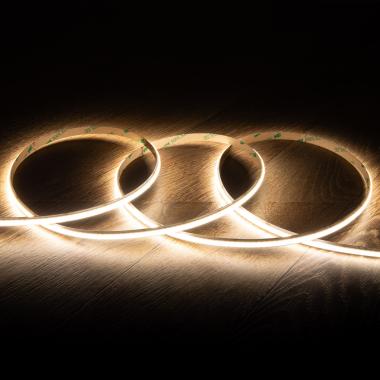
In Stock, delivery in 15-20 days
29.99 £
5m 24V LED Strip WCOB 256LED/m 10W/m 1100lm/m 8mm Wide Cut at Every 3.2cm IP20 CRI90
View product
In Stock, delivery in 24/48h
35.69 £
5m 24V LED Strip WCOB 252LED/m 12W/m 1050lm/m SILICONE FLEX 10mm Wide FreeCut IP65
View product
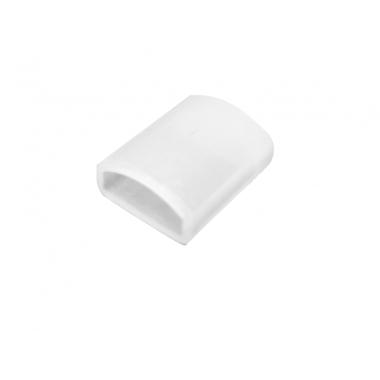
In Stock, delivery in 15-20 days
0.29 £
The End Cap for 220V WCOB LED Strips / SILICONE FLEX / Autorectified, Width 9–10 mm
View product
In Stock, delivery in 24/48h
423.99 £
50M 220V LED Strip Autorectified WCOB Dimmable 260LED/m 15W/m 1350lm/m SILICONE FLEX 10mm Wide Cut at Every 5cm IP65
View product
2. Downlights and spotlights for retail
In the lighting of stores, galleries and retail spaces, high CRI WCOB modules ensure faithful and homogeneous color rendering. This enhances the colors of clothing, food or works of art, making products look more attractive.
3. Architectural and decorative lighting
The WCOB can create linear or diffused lighting effects on walls, staircases, showcases or ceilings, providing a professional, glare-free finish. Its discreet muted appearance makes it perfect for exposed installations.
4. Industrial and outdoor lighting
Thanks to its thermal resistance and durability, the WCOB is also used in industrial highbays, street lighting and stadiums. Its efficiency and reliability reduce maintenance and ensure consistent performance.
5. Automotive and transportation
High-end automotive manufacturers already use WCOB/CSP LEDs in headlights and daytime running lights because of their high luminous density, compact size and robustness. This enables slimmer and more modern headlamp designs.
6. Human-centric and tunable lighting
In offices, hospitals or schools, the WCOB is ideal for adjustable white light systems (from warm to cool), which improve well-being and productivity by adapting to people’s circadian rhythm.
Undoubtedly, WCOB technology is becoming the backbone of modern lighting, both functional and decorative.
WCOB and sustainability: greener light
In a world where energy efficiency is no longer a luxury but a necessity, the WCOB is positioned as an ecological and responsible solution. This technology not only reduces electricity consumption, but also minimizes the environmental footprint throughout its life cycle.
Compared to traditional systems, WCOB modules offer several sustainable advantages:
- Lower electricity consumption: By making better use of the light generated, these modules achieve more lumens per watt, reducing the energy required to obtain the same level of illumination. This directly impacts the light bill and CO₂ emissions reduction.
- Extended lifetime: Thanks to their optimized thermal design, WCOBs can operate tens of thousands of hours without degrading, reducing e-waste.
- Advanced, recyclable materials: Some models integrate highly recyclable ceramic or aluminum substrates, as well as more stable encapsulants that do not release harmful compounds over time.
- Optimized production: By not requiring global phosphorous coating processes, their manufacture means less chemical waste and lower industrial energy consumption.
In short, choosing products with WCOB technology means opting for high-performance lighting with low environmental impact.
How to choose luminaires with WCOB technology for your space
When it comes to buying LED lighting, understanding the technical specifications can make the difference between a mediocre result and a spectacular space. If you’re considering WCOB products, here are some practical tips:
- Define the primary use: are you looking for decorative, functional or professional lighting?
- Check the color temperature:
- 2700-3000 K: warm, cozy light.
- 4000 K: neutral light for offices or stores.
- 5000-6500 K: cold light, ideal for technical areas or outdoors.
- Check the CRI: A CRI above 80 ensures that colors look true and pleasing to the eye.
- Evaluate energy efficiency: prioritize high efficiency and low consumption models.
- Consider the aesthetics of the product off: If the luminaire will be visible, choose white WCOB modules or strips, which are very discreet when they do not emit light.
- Buy in specialized stores: Experienced distributors, such as efectoLED, offer technical advice and tested products with the best certifications.
WCOB is not just a lighting trend: it is an investment in quality, comfort and sustainability.

